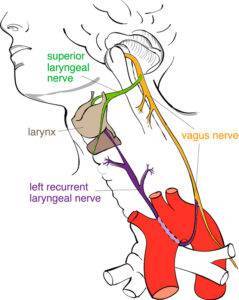
The recurrent laryngeal nerve is a branch of the vagus nerve that supplies nerve fibers for movement and sensation of the vocal cords. This nerve follows a long course descending through a small hole in the base of the skull into the chest, where it loops around the aorta (left side) or the subclavian artery (right side), then loops back upward—or recurs—in the neck, running posterior to the thyroid gland before entering the larynx.
At the larynx, the recurrent laryngeal nerve divides into:
- One branch that supplies the muscles that bring the vocal folds together to make voice;
- Another branch that supplies the muscles that pull the vocal folds apart for breathing.
If the nerve gets damaged anywhere along the way from brainstem to larynx, then some or all of the vocal fold muscles might be weakened (paretic) or completely immobilized (paralyzed), thereby affecting the person’s voice or breathing.